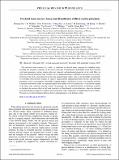Files in this item
Two-kind boson mixture honeycomb Hamiltonian of Bloch exciton-polaritons
Item metadata
| dc.contributor.author | Pan, Haining | |
| dc.contributor.author | Winkler, K. | |
| dc.contributor.author | Powlowski, Mats | |
| dc.contributor.author | Xie, Ming | |
| dc.contributor.author | Schade, A. | |
| dc.contributor.author | Emmerling, M. | |
| dc.contributor.author | Kamp, M. | |
| dc.contributor.author | Klembt, S. | |
| dc.contributor.author | Schneider, C. | |
| dc.contributor.author | Byrnes, Tim | |
| dc.contributor.author | Höfling, S. | |
| dc.contributor.author | Kim, Na Young | |
| dc.date.accessioned | 2019-05-08T14:30:01Z | |
| dc.date.available | 2019-05-08T14:30:01Z | |
| dc.date.issued | 2019-01-15 | |
| dc.identifier | 257822611 | |
| dc.identifier | e291303c-bc4b-4906-9d2e-545e6168def8 | |
| dc.identifier | 85059896945 | |
| dc.identifier | 000455163900004 | |
| dc.identifier.citation | Pan , H , Winkler , K , Powlowski , M , Xie , M , Schade , A , Emmerling , M , Kamp , M , Klembt , S , Schneider , C , Byrnes , T , Höfling , S & Kim , N Y 2019 , ' Two-kind boson mixture honeycomb Hamiltonian of Bloch exciton-polaritons ' , Physical Review B , vol. 99 , no. 4 , 045302 . https://doi.org/10.1103/PhysRevB.99.045302 | en |
| dc.identifier.issn | 1098-0121 | |
| dc.identifier.other | RIS: urn:CAED5E3979FFE6AE37BDEF4AD5D091D7 | |
| dc.identifier.other | RIS: 10.1103/PhysRevB.99.045302 | |
| dc.identifier.uri | https://hdl.handle.net/10023/17668 | |
| dc.description | H.P., M.P., and N.Y.K. are supported by Industry Canada and the Ontario Ministry of Research & Innovation through Early Researcher Awards. This research was undertaken thanks in part to funding from the Canada First Research Excellence Fund (CFREF). H.P. thanks Z. Xie for the travel support to visit IQC. M.P. is a recipient of the Richard and Elizabeth Master Graduate Entrance Scholarship and Natural Sciences and Engineering Research Council (NSERC) Canada Graduate Scholarships-Master’s Program. K.W., A.S., M.M., M.K., S.K., C.S., and S.H. received support from the State of Bavaria. | en |
| dc.description.abstract | The electronic band structure of a solid is a collection of allowed bands separated by forbidden bands, revealing the geometric symmetry of the crystal structures. Comprehensive knowledge of the band structure with band parameters explains intrinsic physical, chemical, and mechanical properties of the solid. Here we report the artificial polaritonic band structures of two-dimensional honeycomb lattices for microcavity exciton-polaritons using GaAs semiconductors in the wide-range detuning values, from cavity photonlike (red-detuned) to excitonlike (blue-detuned) regimes. In order to understand the experimental band structures and their band parameters, such as gap energies, bandwidths, hopping integrals, and density of states, we originally establish a polariton band theory within an augmented plane wave method with two-kind bosons, cavity photons trapped at the lattice sites, and freely moving excitons. In particular, this two-kind band theory is absolutely essential to elucidate the exciton effect in the band structures of blue-detuned exciton-polaritons, where the flattened excitonlike dispersion appears at larger in-plane momentum values captured in our experimental access window. We reach an excellent agreement between theory and experiments in all detuning values. | |
| dc.format.extent | 10 | |
| dc.format.extent | 2256555 | |
| dc.language.iso | eng | |
| dc.relation.ispartof | Physical Review B | en |
| dc.subject | QC Physics | en |
| dc.subject | TK Electrical engineering. Electronics Nuclear engineering | en |
| dc.subject | NDAS | en |
| dc.subject.lcc | QC | en |
| dc.subject.lcc | TK | en |
| dc.title | Two-kind boson mixture honeycomb Hamiltonian of Bloch exciton-polaritons | en |
| dc.type | Journal article | en |
| dc.contributor.institution | University of St Andrews. Condensed Matter Physics | en |
| dc.contributor.institution | University of St Andrews. School of Physics and Astronomy | en |
| dc.identifier.doi | 10.1103/PhysRevB.99.045302 | |
| dc.description.status | Peer reviewed | en |
This item appears in the following Collection(s)
Items in the St Andrews Research Repository are protected by copyright, with all rights reserved, unless otherwise indicated.

